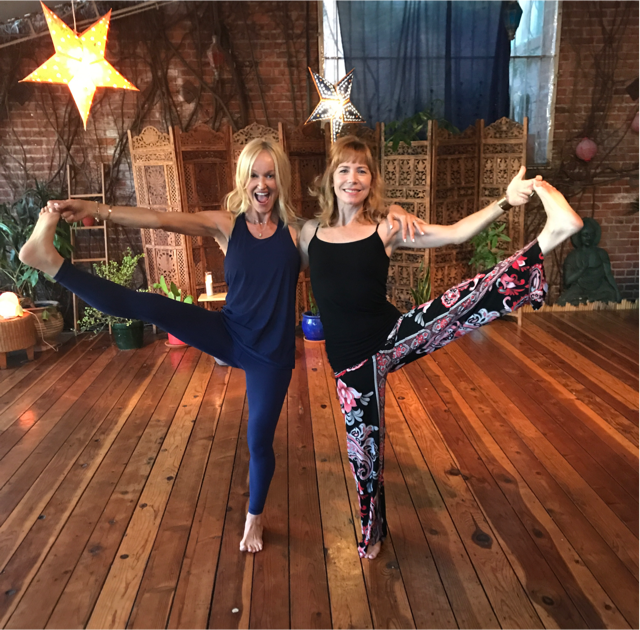Is your yoga practice harming you? Yoga isn’t always harmless. Trusssst me! I’ve been around the block long enough as a yoga teacher to have witnessed scores of injuries. And even worse, at least half the yoga teachers I know (the ones who have been around for a while), have serious physical issues. One of my besties is a renowned yoga teacher on the East Coast, and I know (which is why she’ll remain anonymous), that she can barely get out of bed in the morning for all her minor injuries. And she even admitted to me that she’s beginning to experience symptoms of chronic arthritis. For this reason, it’s really important to know if your yoga practice is healing or hurting you. Yoga should be a mind, body, spirit practice that enhances your body to do what it already knows how to do. It should gently coax your mind, body and spirit to be a little more flexible than it was yesterday. Sadly, this isn’t always the case. A harmful yoga practice can often be the result of either a teacher who is pushing you too hard, or because you’re pushing yourself too hard. So, here’s how to practice yoga safely.
Let’s begin with a basic understanding of what our bodies are designed to do. I’m not a physical therapist, but I can figure out the basics, as I’m sure you can, of how the body is supposed to operate for maximum functionality. And thus, there are a number of yoga poses that I don’t believe our body should be even trying to do. Granted, some of us that have been practicing yoga for decades, and are seriously bendy, might be able to ease into some pretty extraordinary twists and back bends, but this is a very small percentage of people. Many of the more athletic yoga practices, such as an Ashtanga practice, was originally designed for athletic teenage boys! If you are seriously flexible, you might have hyper-mobile joints and over-stretched ligaments. This might look good on a yoga mat to those who can barely touch their toes, but it isn’t always healthy.
So, like almost anything, balance is the key when it comes to a safe yoga practice. There is a Sanskrit term called Ahimsa, which means non-violence. And this is the way that we need to approach our practice, and all of our fitness endeavors. If we push ourselves too hard and fast, we become “violent” toward ourselves, and this is when we contract and tighten energetically. It’s also when we tend to injure ourselves. Iyengar (the Daddy of the school of yoga that many of us know and love), viewed Ahimsa as either doing too much or too little. And therein lies the balance issue. It’s not easy to find balance in your personal approach to your practice, but it’s vital.
Your best guide for safety is your breath. If you stay connected to slow, deep, yogic breathing in every single pose (and for the duration of the pose), you’ll probably stay in “balance”. If you are just hanging out on your mat, not really exerting any effort, you don’t really need to engage in deep yogic breathing. And conversely, if you are straining to perform a pose you shouldn’t be doing, you’ll unconsciously hold your breath. So, the next time you find yourself in a challenging pose, and it can be one as simple as a forward bend, check in with your breath – it should be smooth, deep, and even. If you’re not able to perform this kind of breathing, back out of the pose, bend your knees, dial it back.
Remember, the practice of yoga is actually way more than a physical practice. It is a deeply spiritual practice that encompasses breathing and meditation. There are also many different kinds and schools of yoga: Some are dedicated to studying the ancient philosophy by way of Patanjali’s Yoga Sutras. Some schools of yoga focus exclusively on meditation, and some on a fully integrated spiritual journey. I cannot think of one traditional school of yoga that only focuses on the physical asanas (poses). The purpose of the asana is to enable your body to sit comfortably in meditation. That is the end game. And if you’ve ever tried to sit on a meditation cushion with tight hips, a bad low back, or dodgy knees etc, you’ll probably wish that you had spent a bit more time practicing some simple poses! But, it’s never too late. There’s always a helpful asana for you that that will slowly begin to open up and lengthen tight muscles.
In summation, you’ll know that your yoga practice is helping you if you are not getting injured. And the way not to get injured is to be able to consciously sustain a slow, even breath throughout your entire practice. If the twist or back bend is beyond your capability, your breath will inform you of this – so listen to it. A word of warning: Be very careful of “hot yoga”. It can give your muscles a false sense of what they are capable of doing. I’ve seen a lot of injuries come out of intensely sweaty yoga classes. Moreover the pools of sweat are pretty dangerous in of themselves – not to mention gross if it’s your neighbor’s sweat trickling encroaching into your personal space.
Now, a moment of honesty, which actually prompted me writing this post. I did a yoga class a few days ago, taught by a brilliant Iyengar teacher. My neck is my weakest area, and I have to really protect it by not doing a few key poses that I wish I could. One such pose is a shoulder stand. In the class, it came time for shoulder stand, and everyone got set up to practice it. In that split second when you get to decide “yes” or “no”, I shut out my intuition, and thought, “whatever, I’m a yoga teacher (pride/arrogance), and I can totally do it (competitive) I’ll just be careful”. Even though I started off slowly and mindfully, the overly-ambitious part of me pushed a little too hard. I think once in the pose it felt good, so I pushed it a tad further than I should. I realized what I was doing as I was doing it because my breath became labored. And now my neck is NOT happy. I have nerve twinges down my right arm, and I’ll have to practice a therapeutic form of Savasana for days to allow it to heal. LESSON LEARNED (for this week anyway!)
You’ll probably know if you are a Ahimsa-do-too-much person, or an Ahimsa-do-too-little person. In modern psychology, this would be known as an A or a B type personality. I recommend becoming an A- or a B+ type of personality. This way you move into that sweet spot, and find balance. Balance after all is always the key to optimum health and healing.
And finally, be sure to know how to find a good yoga teacher. A great teacher will help you figure out if your yoga practice is hurting you, or healing you.

btw – I am so thrilled to announce to those of you who haven’t yet heard, that Christine Burke (aka “The Yoga Healer“), will be teaching a healing yoga practice everyday of my upcoming Hello Gorgeous Retreat in Palm Springs. We are pictured above. She will teach you a personal customized home yoga practice. The thing I love most about Christine is that she will help you with specific physical and emotional issues. She calls it “prescriptive” yoga. Still a couple of spots left, so email Katharine@GorgeouslyGreen.com if you are still considering it. There’s still a small window of time left to book.
Also, coming up is my Chair Yoga series on You Tube. So make sure you are subscribed to my channel. This is perfect for those of you with any kind of physical limitations, balance and other issues that make it hard for you to confidently roll out a yoga mat.



